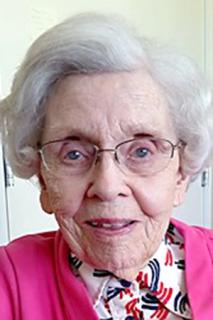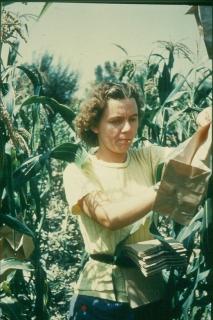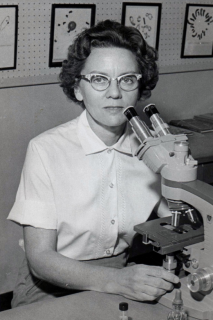Blazing a Trail, Building a Legacy: The Extraordinary Life of Rosalind Morris
May 31, 2023 - Denice Rackley
Rosalind Morris led an extraordinary life that ended 26 Mar. 2022, just shy of her 102 birthday. Her legacy lives on, not just through her scientific and professional accomplishments, but also thanks to a generous donation she made to the Agronomic Science Foundation (ASF), the philanthropic arm of ASA, CSSA, and SSSA. Donations to ASF enable a wide range of programming, such as awards, lectureships, and service initiatives and help to sustain the value and relevance of the Societies into the future.
“We at the Foundation are grateful for Dr. Morris’s scientific contributions and for her decision to build a legacy with the Foundation,” says Samantha Miller, ASF Chair. Through this donation, Miller says the ASF board and Society members will “ensure her legacy will inspire and support the innovative agronomy professionals following in her footsteps.”
Morris’ footsteps propelled her to heights few women of her day reached.
A world-renowned cytogeneticist, Mary Rosalind Morris was born in Wales to schoolteacher parents in 1920. Her father, in poor health from the influenza epidemic of 1918, was counseled to begin an outdoor life. Immigrating to Canada in 1925, the family bought a 50-acre fruit farm in southwestern Ontario. Adapting to this new agronomic lifestyle improved her father’s health and provided Morris’ first steps into a career that spanned over 40 years.
Attending a one-room schoolhouse for her elementary education and then a two-mile walk to town for high school, her favorite class was literature. She enjoyed writing poems and sending them to her grandfather in Wales and briefly considered a career in journalism.
Morris helped with farm chores, spraying trees and harvesting fruit after school, and became increasingly interested in agriculture. Graduating high school in 1938 with the highest marks in the county, and with both parents having a college education, it was a given that Morris would attend college. Her mother thought a degree in home economics might be best while her father encouraged her to study agriculture.

Morris became interested in fruit breeding and attended Ontario Agricultural College (now the University of Guelph) where she earned her bachelor of science and arts in Horticulture in 1942. At a time when few women pursued graduate studies, and even fewer women chose science-related studies, Morris applied to Cornell and was accepted into the university’s plant-breeding program. Out of the 150 individuals in her class, she was one of only five women. Morris was then offered a teaching assistantship due to most college-aged men fighting in WWII.

Morris began her graduate studies concentrating on fruit breeding but transitioned to studying crops. She assisted her adviser, H.H. Love, professor of plant breeding, with research on buckwheat, an important crop in New York. Morris also served as a teaching assistant for Robert Cushing, who at the time was an assistant professor of plant breeding at Cornell. Morris taught classes in plant breeding and genetics. In many of these classes, she taught graduate students about the structure of DNA.
Inspired by Another Pioneer
Barbara McClintock, the first woman to win a Nobel Prize in Physiology and Medicine, provided inspiration for Morris. McClintock, a cytogeneticist in the 1940s who studied chromosome breaking in maize, challenged existing concepts of what genes were capable of and discovered that some genes could be mobile, moving from one location on the genome to another (known as transposons or “jumping genes”). During a conversation in 2006 with Marla McIntosh, Professor Emeritus at the University of Maryland, for “A Century of Women in Agronomy: Lessons from a Diverse Life,” Morris said Barbara McClintock was “making strides with her theories about moveable elements and received a lot of criticism, but she pioneered and persevered and went right ahead.” Morris went on to emulate these traits in her own life and career.
Seeing her first chromosome under a microscope at Cornell captivated her imagination and interest, altering her future and proving to inspire many others whose lives she touched.
“It was a joy for me to just sit at a microscope seeing beautiful chromosomes,” Morris told McIntosh during their conversation. Morris, dedicated to intricate exploration, was well on her way to shattering more than one glass ceiling while becoming a world-renowned cytogeneticist.
She earned her Ph.D. in Plant Breeding and Genetics from Cornell in 1946, one of two women to do so at the time.
Cushing recommended Morris for an assistant professorship at his alma mater, the University of Nebraska–Lincoln, working with the late Elvin Frolik on an Atomic Energy Commission grant in a newly created plant cytogenetics program. Being from Canada, there were some roadblocks to hiring Morris and paying her with state funds meant only for U.S. citizens. Frolik, and then department head Franklin Keim, worked to acquire other funding sources to hire Morris.
At the time, women were technicians but not instructors. However, Morris again shattered the preconceived notions of the day. In 1947, she accepted the assistant professor position, becoming the first woman faculty member hired by the Department of Agronomy and Horticulture at the University of Nebraska. Frolik and Keim proceeded to garner changes in regulations that allowed Morris to retain her position and thus successfully navigate one more hurdle.
With the worldwide concern over the effects of the atomic bomb on food crops, Morris studied the cytogenetic impacts of atomic irradiation on corn. Testing different doses and types of radiation, Frolik and Morris found chromosome abnormalities showing that radiation could break or rearrange chromosomes and reduce corn fertility and seed amounts. This research would also become important by revealing the potential of mutations to provide genetic variations for crop improvement.
In addition to research, Morris instructed graduate students in statistical genetics, chemical genetics, cytogenetics, and plant genetics. She was promoted to associate professor in 1953 and professor in 1958. In 1975, Morris joined the prestigious wheat research team that included Virgil Johnson, John Schmidt (both geneticists and plant breeders), and Paul Mattern (cereal chemist).
Bread Wheat Cytogenetics
“Rosalind Morris developed elegant cytological materials that were shared and used around the world,” says P. Stephen Baenziger who met Morris when he joined the faculty in 1986. “The main focus of her work became the cytogenetics of bread wheat,” explains Baenziger, Emeritus Professor and Wheat Growers Presidential Chair at the university. “Morris recognized the pioneering work of Dr. Ernie Sears, who developed a remarkable series of chromosomal lines to study the genetics of bread wheat and would substitute chromosomes from one cultivar into another wheat cultivar to understand the role of that chromosome.”
Morris built upon the work of Sears by creating similar genetic materials in ‘Cheyenne’ wheat (the foundation parent of the Nebraska wheat-breeding efforts) and ‘Wichita’ (an important cultivar in Kansas), Baenziger says. Her initial research led to the discovery of where genes for end-use quality (bread making), winterhardiness, and disease resistance were located in the wheat genome.
“In later years, she developed the Cheyenne and Wichita chromosome substitution line series,” Baenziger says. “In this series, each chromosome pair of Cheyenne was replaced by the similar chromosome pair in Wichita and vice versa. This series allowed researchers to locate chromosomes that affected subtle differences in grain yield, grain volume wheat, components of yield, winterhardiness, plant height, bread-making capability,” and a myriad of other agronomically useful traits in hard winter wheat.
“With the advent of molecular markers, these substitution lines and additional crosses were used to identify the location and precise number of genes affecting agronomic traits, disease, and end-use quality, which greatly expanded our knowledge of understanding complex traits in polyploid species. For those of us not skilled in cytogenetics, the care and validation to create the Cheyenne and Wichita substitution line series was as extraordinary as the new knowledge their evaluation provided to the wheat community,” Baenziger says.
Ken Vogel, who took her graduate plant cytogenetic course, went on to use what learned from Morris in his research on prairie forage grasses. “At the time, there was very little genetic information on prairie grasses such as switchgrass. The knowledge I gained from her was invaluable in my research.” Working with her as a student and later as a USDA research geneticist and as an adjunct faculty member, Vogel says he “was always impressed by her detailed, hands-on approach to her work and with her students.”
Quiet Determination
Morris approached her career and her life with quiet determination. “She was a remarkable person,” Baenziger notes. She was a meticulous researcher, with every bit of material validated, and an incredible editor, he adds. “She spoke the queen’s English better than the Queen. Rosalind was exceptionally kind, soft-spoken and modest.”
During the interview with McIntosh, Morris stated, “I didn’t have a competitive attitude. My approach was to demonstrate through accomplishment that I was worthy of being a faculty member.”
In 1979, Morris became the first woman to be named Fellow by ASA. In 1980, she was the first woman in more than 50 years to serve as president of the Nebraska Academy of Sciences. She was also named Fellow of AAAS and CSSA.
Morris retired in 1990 after a 43-year career. She believed agronomy held answers for many of the world’s problems, including famine, alternative fuel sources, and reducing global warming. She was steadfast in her belief that, as global citizens, we need to understand each other and work together to solve problems.
“Women who have cut their own trail send a ladder back down to help others reach and exceed the heights of their own career,” Miller says. Gifting a portion of her estate to the Societies, Morris was one of these women.
“Rosalind Morris created an opening through which many women have followed,” says Kim Kidwell, Associate Chancellor for Strategic Partnerships and Initiatives, University of Illinois at Urbana-Champaign. “Her gift strengthens that pathway of opportunity within the Societies for network building, support, and for others to follow in her footsteps, contributing to the advancement of science by engaging with this community of colleges.”
This story was provided by: https://doi.org/10.1002/csan.20967
